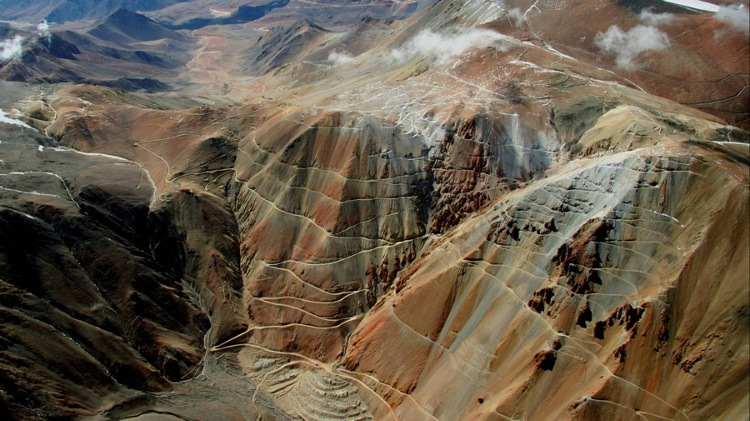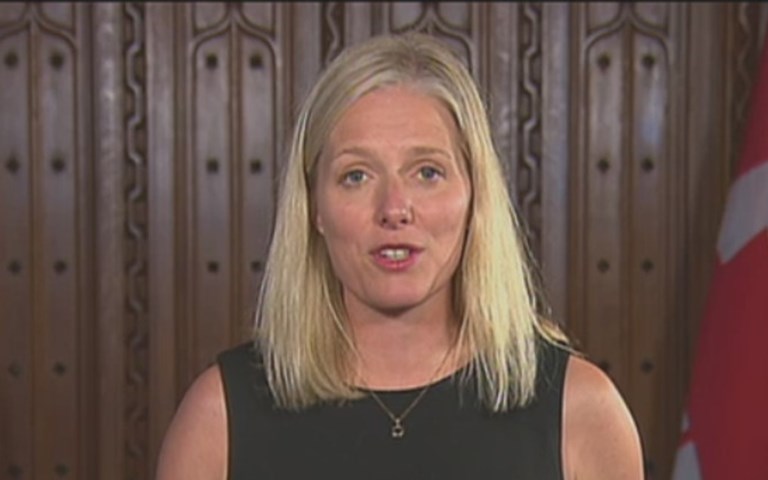Environment and Climate Change Minister Catherine McKenna first announced the government's two-part carbon pricing program in a May news conference. The draft legislation expands further on the output-based system for industrial emitters. Screencap courtesy of CPAC
Updated Jan. 17 with comment from the Canadian Association of Petroleum Producers
Industrial emitters like mining, potash and oil and gas operations will pay a price on carbon once they emit above a certain level of pollution per year in provinces that adopt the federal carbon pricing plan.
According to the government’s carbon pricing framework and a draft of the Greenhouse Gas Pollution Pricing Act, released Monday for public comment by Environment and Climate Change Minister Catherine McKenna and Finance Minister Bill Morneau, industrial facilities will be given an annual limit on the total greenhouse gases (GHG) they can emit before the carbon price kicks in. The limit will be defined as an amount of GHG emissions per unit of product, and “in most cases” will be set as a percentage of the sector’s national average.
The more operations exceed their annual limit, the more they will pay. If they fall beneath the limit by 30 per cent or more, they’ll be able to earn credits that they could sell to higher emitters or save for another year.
In an emailed statement to CIM Magazine, Canadian Association of Petroleum Producers' (CAPP) spokesperson Tonya Zelinsky said "any government action taken to meet climate change commitments should consider Canada's ability to attract investment and remain competitive while continuing to be a global energy supplier."
In the framework, the government said the output-based system will "create a pricing incentive to reduce greenhouse gas emissions from industrial facilities while limiting the impacts of carbon pricing on their international competitiveness, particularly on their ability to compete with similar businesses in countries that do not have carbon pricing."
Monday’s draft legislation also includes new charges on fuels like gasoline, propane, diesel and natural gas.
The federal plan goes into effect this year, with the cost of carbon starting at $10 per tonne. It will increase by $10 a year every year to $50 per tonne by 2022.
Related: “The problem I have with the carbon tax, generally, is that we can’t do anything about it." Miners grapple with the cost of carbon
In the first two years of the plan, the output-based system will apply to industrial operations that emit 50 kilotonnes or more of “carbon dioxide equivalent” per year, the ministers said.
Provinces that have not implemented their own system by September will have the federal backstop program imposed on them. Currently, Ontario, Quebec, British Columbia and Alberta have implemented carbon pricing systems that meet federal requirements.
“Four out of five Canadians live in jurisdictions that already have a price on carbon,” McKenna said in a news release, “and right now, those provinces are leading Canada in job creation.”
In September Nova Scotia proposed a cap-and-trade program, and a month later Manitoba set its own carbon price at $25 per tonne, which will be in compliance with the federal plan until 2020. Yukon Territory will adopt the new federal system. The rest of the provinces and territories have not yet set up a system, and Saskatchewan Premier Brad Wall has threatened to sue the federal government over the carbon pricing plan.
The government has stressed that the federal plan will be revenue neutral, with all funds derived from it returned to the provinces and territories to invest as they choose.
CAPP suggested funds could be best invested in "technology and innovation" to "advance our goals to cut emissions while increasing revenues to government, communities and industry," Zelinsky said.



